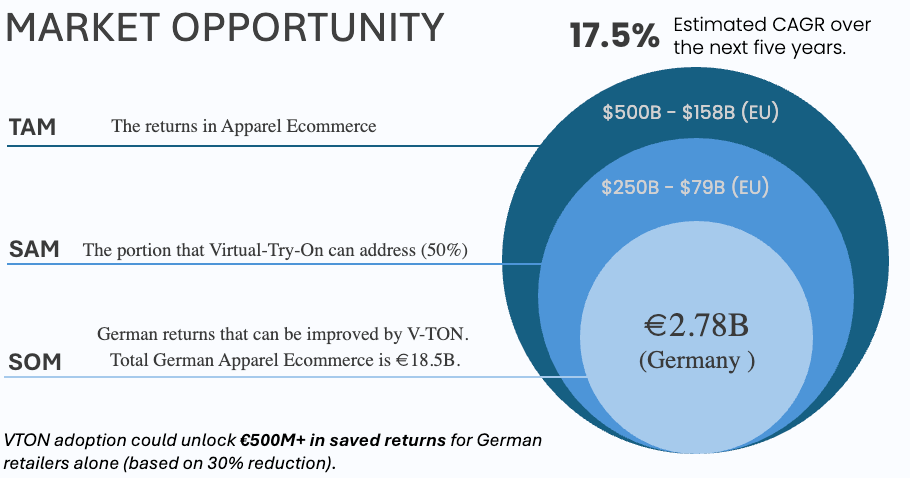The Next Generation of Virtual Try-On for Fashion E-commerce
- M K
- Mar 6
- 4 min read
Updated: Apr 28
Many consumers hesitate to purchase clothing online due to uncertainty about its appearance on themselves. Virtual Try-On (VTON) technology effectively addresses this issue by enabling shoppers to visualize how garments would look without physically trying them on. In the fashion industry, VTON has emerged as a groundbreaking solution, potentially reducing high return rates—estimated at 30-40% for online fashion retailers—and enhancing customer confidence. As more shopping transitions to online platforms, retailers offering sophisticated and intuitive "try before you buy" options secure a substantial competitive advantage. Virtual try-on technology has proven transformative, revolutionizing the online shopping process by allowing consumers to envision clothing on themselves prior to making a purchase. At SensePro AI, we are proud to introduce our innovative solution that redefines virtual try-on, delivering exceptional accuracy with rapid, cost-effective performance.

The Transformative Role of Virtual Try-On in Fashion E-commerce
Virtual try-on is much more than a trendy feature; it’s a critical component in modern fashion ecommerce that addresses several key challenges. Enhanced customer engagement is achieved by enabling shoppers to see how garments fit and move, creating an immersive shopping experience. This interactive process helps customers connect with the brand on a deeper level, ultimately boosting satisfaction and loyalty. Reduced return rates are another benefit. When customers can virtually try on products, they make more informed decisions, leading to fewer mismatches between expectation and reality. Virtual try-on systems also adapt to individual body shapes and styles, offering personalized recommendations that enhance the overall shopping experience. This tailored approach not only increases conversion rates but also builds long-term trust. Additionally, advanced virtual try-on solutions bridge the gap between online and in-store shopping. They come remarkably close to replicating the tactile experience of trying on clothes in a physical store, giving shoppers the confidence they need to buy without seeing the product in person.
The Evolution of Virtual Try-On Technology
Initially, virtual try-on solutions relied heavily on virtual reality (VR) or augmented reality (AR) approaches. These systems had significant limitations: they required specialized hardware like AR glasses or depth-sensing cameras, often involved complicated setup procedures, and created artificial-looking results that didn't truly represent how clothes would drape. While these methods worked well for rigid items such as glasses, they struggled with dynamic fabrics. These barriers meant that although the technology was promising, it remained inaccessible for everyday shoppers and impractical for widespread adoption.
The breakthrough came with AI-powered generative models, particularly diffusion models. These sophisticated algorithms could transform an image of a person and a separate image of a clothing item into a realistic composite showing that person wearing the garment. Diffusion models excelled at creating photorealistic images, understanding how fabric drapes on different body types, preserving the textures and details of complex garments, and adapting to various poses and lighting conditions. The results looked remarkably authentic, finally bringing virtual try-on to a level that could genuinely influence purchasing decisions.
Despite these impressive results, diffusion models came with a significant drawback: they were painfully slow. Traditional diffusion-based VTON systems required over 50 computational steps to generate a single image, took 10-20 seconds per try-on, and consumed substantial computing resources. This slowness presented a major obstacle. In e-commerce, where users abandon sites after just a few seconds of delay, waiting 15+ seconds to see how a shirt might look was simply not viable. The computational cost also made scaling these solutions prohibitively expensive for many retailers.

Our Breakthrough: Ultra-Fast Virtual Try-On
At SensePro AI, we've engineered a solution that dramatically reduces the required processing iterations to generate a natural try-on using diffusion model—from 50 down to just 2 or 4. This transformation offers several key benefits, ensuring our optimized method delivers instant visual feedback, allowing customers to experience seamless, interactive try-ons that match the pace of modern digital interactions. This innovation also significantly reduces computational demands, cutting operational costs by 98%, thus making the technology accessible for large-scale deployment. Remarkably, even with fewer processing steps, our system maintains high levels of detail and accuracy, rendering complex clothing textures and intricate poses with impressive realism. Brands can deploy it across large catalogs and serve millions of users without compromise.
We made deep architectural modifications and training refinements using an in-house comprehensive dataset to adapt the model for handling complex garments, such as multi-layered outfits, translucent fabrics, and patterned textures. We ensured preserving pose alignment, so garments wrap naturally around the human body in dynamic positions and rendered fine fashion details, from lace and denim to sequins and stitching. This adaptation makes our model exceptionally good at understanding and recreating the nuances of fashion, bringing clothing to life in the most realistic way possible. For shoppers, this technology transforms the online shopping experience, making it more intuitive, confident, and enjoyable. You can quickly try dozens of outfits in seconds, see how different sizes might fit, and make better-informed purchasing decisions. For retailers, the benefits are equally compelling, leading to lower return rates and increased customer satisfaction.
The Future of Fashion Shopping
We're witnessing the beginning of a fundamental shift in how people shop for clothes. As virtual try-on technology becomes faster, more accurate, and more accessible, the line between physical and digital retail will continue to blur. What sets SensePro AI apart is our commitment to making this technology practical and scalable. By solving the critical speed and cost barriers, we're not just creating impressive tech demos—we're delivering a solution that works in the real world, for real shoppers, at real scale. The days of hesitating before an online purchase because "I'm not sure how it will look on me" are coming to an end. Virtual try-on is no longer just a futuristic concept—it's a practical reality that's transforming fashion e-commerce today.



Comments